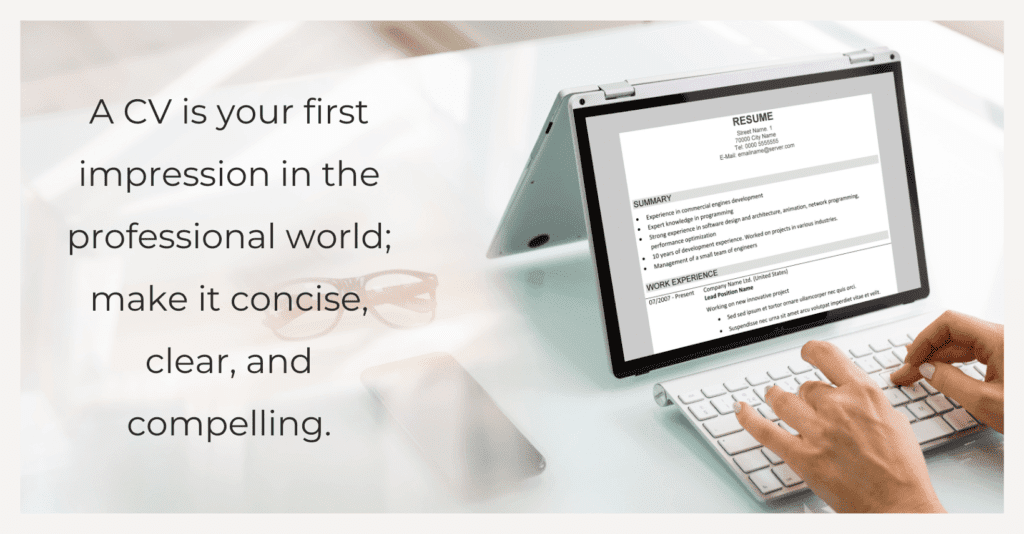
Well over a decade ago, I remember attending a meeting with a recruiter, and when I say she massacred my CV, I’m putting it mildly. Understandably, I felt upset and disillusioned. Could she have gone about it with a bit of grace and worded her feedback more constructively rather than destructively? Most definitely. But my key takeaway from this experience, albeit its poor message delivery, was this: she was right. My CV was an absolute mess. Different font sizes, irrelevant information, possible typos. You name it. As inconvenient and harsh as this truth may have been, it was an eye-opener. I needed to swallow my pride and revamp my CV.
So, you might ask, what’s considered a good CV nowadays? While there’s no standard recipe for the ‘perfect’ CV, there are indeed some star ingredients which are needed to whip up the right document and put your best foot forward.
The below list includes some essential components I think a polished document should include:
Good Writing
I cannot stress how important a well-written CV is. Take it from someone whose document was a train wreck: whatever you decide to include, make sure you proofread it with a fine tooth comb. If needs be, ask someone else to read it and give you some honest feedback and, more importantly, be receptive to it.
If you don’t have anyone to help you out, take a break from your CV for a good few hours, a day even, so the next time you look at it, you will do so with ‘fresh’ eyes. It’s amazing how many mistakes you’d be able to spot when you’re reading it from a new perspective. Of course, applicants aren’t expected to use Oxford, degree-level English, but it does need to be legible and intelligible. So avoid fancy fonts, and don’t overcomplicate your descriptions. Use simple writing. This is where the phrase ‘less is more’ needs to be put into practice.
Font Choice and Margins Also Matter
To ensure readability, be sure to choose a sans-serif font between sizes 10 and 11. Here are some examples of appropriate font choices:
- Arial
- Avenir
- Calibri
- Helvetica
- Lato
- Roboto
- Proxima Nova
- Verdana
As for margins, a good standard would be to have a width of between 0.5 to 1 inch. Margins that are too large leave a lot of negative empty space. On the other hand, margins that are too small can make the page look crammed and overfilled. Both extremes will have the same effect of being distracting or off-putting to recruiters or hiring managers.
Structure and Consistency
Think about it: when you’re reading any sort of text, be it a book’s chapter or excerpt in an article, it’s more easily digestible when it’s sectioned into ‘edible’ tidbits of information. The same applies to your CV.
It should be clean, organised and easy on the eyes. This means including sections, subheadings, paragraphs and bullet points (if and where relevant) helps. Needless to say, you need to be consistent in the format. Stick to the same font, sizes and headings so it’s easy to see which section the text being read ‘belongs’ to. Here’s what you should use and where:
- Headings or subheadings: To distinguish sections with relevant information (eg. ‘Job History’ or ‘Education’). These are made by using bolder, larger or underlined fonts.
- Bulleted lists: Organise your text for parts that can be collected into ‘lists’. These would be great for skills or awards.
- Bold: Apart from properly sectioning headings and subheadings, it might be good to embolden other important words, such as your name and job titles. This sets apart noteworthy words or phrases from the rest of the text.
Remember, recruiters and/or employers get dozens, if not hundreds, of CVs for an advertised post, so they won’t be reading each one from start to finish. They just scan through the seemingly never-ending piles of pages to see if a candidate’s profile might catch their eye. You want whoever’s reading it to ‘savor’ the information you’ve provided, and leave them wanting (to learn) more.
Relevant Information
Exclude any jobs, skills or experience which don’t add value. Your list of previous workplaces should be in some way or another related to the sector of your current job application.
Sure, having worked in a fast food restaurant might have been a great character-building experience. You probably gained indispensable skills of teamwork and leadership, but it’s completely irrelevant to include if you’re applying for a job within a totally different sector like, say, a marketing agency. Instead, you can include an ‘about me’ section (ideally at the top part or left/right-hand margin after the list of your contact details) where you highlight certain character traits which are transferable to the role.
For instance, using descriptors like being a ‘team player’, ‘collaborative’, and having a positive ‘can do’ attitude might all have a better ring to your profile description. And, if you prefer lesser cliche adjectives or terms, a thesaurus is your friend! The same applies to education and the list of credentials. No one’s going to call your kindergarten or primary school to check if you’ve really attended. Don’t waste valuable space which would otherwise be used for more useful information.
Personalisation
There’s nothing wrong in including something about yourself, your favourite quote or a short sentence describing who you are. After all, they’re looking at an individual’s job history and other sensitive information, so adding a personal touch might be an indirect way of showing your character and personality.
You can also explain what you can bring to the role and your current career aspirations. This is a good opportunity to give your prospective employer a useful overview of what you’re all about, covering your career background as well as current and future interests. Here, you can showcase why you’d be a suitable candidate for the job and how you’d make an impact within the firm. It’s also a great tool to use to convince employers that the rest of your CV is worth reading. Don’t overdo it, though. Keep it simple and concise. Try not to exceed five lines of text.
Personal Details
As for other information such as date of birth, race and gender – these are (technically) all unnecessary details. Of course, one may argue that an interviewer may still be ageist, racist or sexist once they meet you in person or via video call. But if that’s the case, you have no place working in such a hostile environment anyway. Let them help you dodge that bullet. With that said, there’s no hard and fast rule of what to include in terms of such information, aside from the mandatory contact details such as phone number and email address. You might also want to include a link to your LinkedIn profile.
Photo: Yay or Nay?
Again, this is up to the candidate’s discretion. My advice would be, if you’re going to opt for a photo, be sure it’s a professional-looking one. You’re not posting for your Instagram or TikTok followers. Think along the lines of a LinkedIn profile picture. One where you look cleaned up, as though you’re ready to go for an important job interview or meeting.
Length
This component is rather subjective. There are some CVs which are one-pagers that pack a punch and others that are several pages long and are still worth reading, despite their lengthiness.
It’s good to point out that the average length of a CV should be about two to three pages. But again, employers don’t have strict requirements for this. Nevertheless, anything over three pages might be too long. Especially if you’ll also be sending a cover letter to complement this document.
Keep in mind that the main aim of your CV is not to give your exhaustive work history since you first entered the working world. Instead, it should be a sneak peek into what your work-related background is all about whilst listing any relevant credentials. Think along the lines of efficacy and impact: does it present the right information about you, and do you think it’ll leave a lasting impression?
Wrapping Things Up
So there you have it. Some of the main components I believe make up a good CV. Remember, a polished CV is crucial because it’s the initial contact you have with your potential employer. This is why you need to take advantage of this chance to make the best first impression possible. And who knows, if you’ve left enough impact, you might be lucky enough to be shortlisted for a job interview and one step closer to landing the job you want!

Hi there, I’m Michaela Mihailovic, a Content Manager with an affiliate marketing company. I’ve always had a passion for writing. To me it’s an art form and cathartic outlet where I’m able to put pen to paper my thoughts, opinions and everything in between. I consider myself quite opinionated on topics that matter – women’s health and rights being some of the subjects I hold dear to my heart. I’m the kind of person who doesn’t shy away from asserting her views, but I also believe in the art of a healthy and respectful debate.



